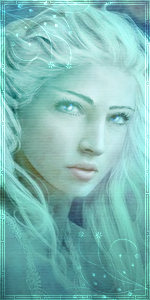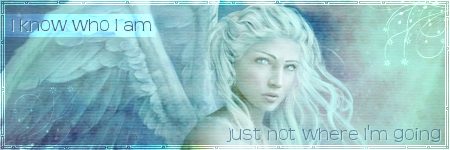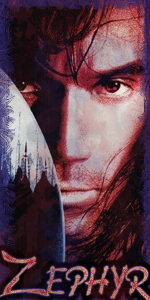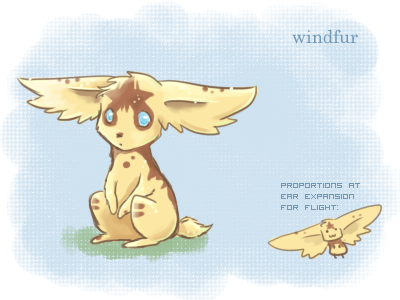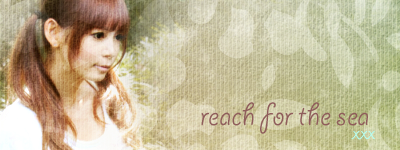Name: windfur (formal name: star-eared lemur)
Scientific Name: lepurimae sanufervens
Pronunciation (sc): le - piu - rhee - MAY SAH - niu - FER - ven
Category: Other / Pet / Useful
Type: Avian
Size: Small
Region: Flatlands
Lifespan: 2-15 years wild* / 15-35 years domesticated [*The high variation is due to overhunting.]
Appearance:
The windfur is a small avian creature with a large head, small body, and strangely no wings. Its short, silky smooth fur comes in a variety of warm and neutral hues, typically peach to pale honey gold in the main body area with patches and speckles of rose-brown along its back and forehead. It always has about two to three speckles on its chest. Rarer colors of the windfur include silvery storm blue and ice blue. The upper forehead of the windfur is colored by a darker shade that resembles somewhat the shape of a star. The round, bright jewel-like eyes of the windfur are set beneath this feature.
The most identifying characteristic of the windfur is definitely its ears, which are spiked but deceptively not really star-shaped. They are, however, large for its size and able to expand to unbelievable degrees that render the windfur capable of flight. These wing-like ears can not only take it across the skies but also allow it to suspend itself in the air like a balloon. The ears' unique design and the windfur's light weight allow it to stay afloat for up to several hours. Although it cannot fly very fast, it is able to achieve tremendous heights. The windfur's fear of these extreme heights, however, keep it below cloud level.
Another special attribute from which the windfur gets its common name is the appearance of its fur in the wind. Depending on the strength and degree of the wind it is exposed to (varies in the flatlands), its fur changes in hue or even glimmers. The color usually shifts only in small shades, however, and only extreme conditions would compel it to become bright and unnatural. Despite rumors, the windfur's color is only affected by wind and not emotions.
Due to its large ears and short, stubby tail, the windfur has been interestingly compared to rabbits and even baby bears, particularly when viewed by a near-blind person from the back. The detailed physical attributes of the windfurs are difficult to examine due to their rarity, although they have been speculated to be a cousin of the lemurs.
Behaviour: In its natural habitat, the windfur spends its days frolicking with loving friends and family and playing games of dirtball* among the trees and grasses. It is both a daytime and nighttime creature, although typically it sleeps in the night. However, with interference from hunters and other wild animals, the windfurs living in more threatened areas have become increasingly nocturnal. This perhaps also shows their powerful ability to adapt.
Generally and when domesticated, the windfur can be a rather shy creature around strangers. It is curious but quiet around new people, and sometimes hides when it feels scared. It is very attached to and trusting of its owner while also being respectful of his/her wishes and privacy, but long absences and sharp actions can make the sensitive windfur feel lonely, unwanted, or even sadly bitter. Due to its powerful and everlasting dedication, however, the windfur would never abandon or betray its owner unless expressively requested by said owner, even when it is betrayed itself. One could say that the windfur is extremely obedient and even protective. It's very modest and tries to be helpful whenever possible, even if it messes up. If it happens to unintentionally aggravate someone, it tries to make up for it; windfurs rarely truly deserve punishment. In the domesticated windfur's eyes, its owner is number one. This can attract jealousy from other windfurs who have no owners.
The windfur is also intelligent enough to be trained. It can learn everything from playing fetch to helping its owner put a shirt on. However, it has a frequent tendency of mixing up words in any language except Sylvan (and even in Sylvan it has problems). For example, it can easily confuse the word "drink" with "peanuts". This can lead to unwanted actions. Therefore, owners must be strictly careful when giving orders.
Although it is constantly aware of the emotions of its owner, the windfur tends to misunderstand the emotions of other people. It gets confused during highly troubled times, for its innocent, feathery little soul was not built to withstand extremely negative feelings such as pain and hatred. And unfortunately, because the windfur is usually so warm, loving, and seeking of friends, hunters have little difficulty luring out the windfur from its shelter. Its fur being priceless, the population of windfurs, originally already a rare species, has declined over the years with only a few areas guaranteed protection.
Diet: Wild windfurs do not have a very strict diet. They eat nuts, berries, leaves, and any edible thing that they can get their little paws on. Their instinct prevents them from eating poisonous foods like mushrooms, but mistakes do happen. A domesticated windfur appreciates any food given to it as long as it is natural and authentic (no pellets cranked out of machines). Windfurs even enjoy gourmet meals when given the chance. They are typically vegetarians, for too much meat weighs them down with bellyaches. They generally eat little when alone but excessively when surrounded by people.
Habitat: Windfurs are highly adaptable and can survive in forests, cities, and coastsides. They are able to withstand varying degrees of temperature but must be ingenious in order to survive in extreme conditions. For example, a windfur would teach itself to build an igloo in the snow. Their most favorable and populous habitat are the flatlands, where they dig burrows in the ground or live in tree trunks. They enjoy places with room to play and skies to fly in. A domesticated windfur's favorite place to stay is nestling in his owner's coat, shirt, or whatever he or she is wearing.
Breeding: Windfurs breed only when the weather is nice and temperate. A female can produce up to a litter of four. Because they spend more time playing than anything else, windfurs do not reproduce frequently, which makes it necessary that they are not bothered in order to keep their population steady. Windfurs are considered babies for the first half year of their lives, and they do not stop developing until their fourth year. Wild windfurs may not live much of their life as an adult due to overhunting.
Strengths/Abilities: The windfur's unique way of flying and wind-affected fur color can be considered special. They have
limited extreme intelligence and decent agility and defensive skill. Every year, male windfurs cough up a star-shaped pellet with healing properties.
Weaknesses: They have an unconventional habit of allowing themselves to fly in storms, which kills off lightning-prone windfurs by the numbers. Also, when windfurs eat too much they swell up into balloons, an effect that takes a few days to wear off. Obviously, they cannot fly during this period.
Uses: The windfur's fur can be used for highly expensive and exotic clothing. Because of its color-changing nature, it is particularly beautiful when used in designs and thus highly seeked. Ownership of such fur can be considered a sign of wealth. Every year, male windfurs cough up a star-shaped pellet with healing properties. These saliva-covered balls are not as sought after.
Origin: Due to their higher comprehensin of Sylvan than any other language, it's said that the earliest windfurs emerged near the nymphs' habitat and became their companions. The appearance of the windfur suggests a potential evolution from the lemur, from which it gets part of its name. The strange usage of ears for wings has been attributed to a strong genetic mutation. Some people say that Xanth nodded off to sleep while creating the windfur and spawned its flight capability in the wrong area.
Other Info: Although windfurs make great pets, only a small percentage are actually domesticated because of their insubstantial population. Protection from its owner is the primary reason why the domesticated windfur's lifespan is so much longer than the wild windfur's one. Some windfur owners claim that their windfurs are able to lift them into the sky, but such displays of strength have yet to be proven. Others claim that the windfur can enter dreams, which is dismissed as a legend.
*Dirtball is a game in which windfurs make balls from dirt and throw them in the air, kicking them at one another like a sport. They enjoy many games such as this in friendly competition, but windfurs are sensitive enough to allow everyone to win at least once in order to avoid injured feelings.
Credits: The windfur image was drawn by me on SAI. I give Elysia permission to use it if it desires.



 Sign In
Sign In Register
Register Help
Help
 This topic is locked
This topic is locked


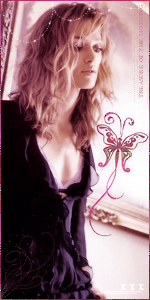

 MultiQuote
MultiQuote

